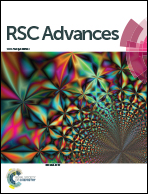Cyclodextrin-tunable reversible self-assembly of a thermoresponsive Y-shaped polymer†
Abstract
Tuning the reversible self-assembly process of stimuli-responsive topological polymers in solution has theoretical and practical significance. In this study, we covalently incorporated β-cyclodextrin (β-CD) onto a thermoresponsive Y-shaped polymer to investigate the influence of β-CD on the morphology, size and reversibility of self-assemblies. Transmission electron microscopy, atomic force microscopy, and dynamic light scattering results indicated that the morphology and size of the polymer self-assemblies present a good reversibility during the whole heating–cooling process. The self-assembly morphology gradually changed from dot-like micelles to noticeable core-corona-structured micelles, and finally back to dot-like micelles again. Meantime, the size of self-assemblies first increased from several tens of nanometers to hundreds of nanometers, and then decreased to get close to the initial value. The attached β-CD units have a pronounced regulation effect on the reversible self-assembly process. The corresponding mechanism is attributed to the abilities of β-CD itself to conduct inclusion complexation, induce intermolecular hydrogen bonding interaction and present steric hindrance. Our study has expanded a new idea to reversibly tune the morphology and size of stimulus-responsive topological polymer self-assemblies.


 Please wait while we load your content...
Please wait while we load your content...